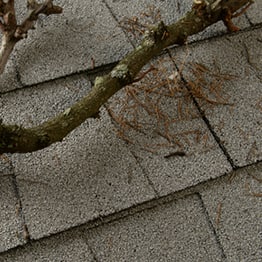
Roof damage from a storm?
Where to start when you have storm damage

Inspect your roof

Review your homeowners' insurance policy

Find a contractor
Inspect your roof using the I.O.U method:
Begin in the attic, if it’s accessible, during the daytime. Use a flashlight wherever necessary.
- Sunlight showing through the wood
- Sagging
Walk around your house, examining as much of the roof as you can see from the ground.
- Missing, cracked or curled shingles
- Debris
- Dark Patches
- Bent or detached flashing
If you are comfortable climbing a ladder, you can get a better look at your roof up
close.
- Loose nails
- Gutter debris
How do I know if I need a new roof? Types of roof damage
Here are just a few of the visible signs of damage. Click for more resources to determine if you need a new roof.

Hail Damage
Hail stones can travel as fast as 100 mph. Your roofer can help identify less obvious impact sites.

Wind Damage
Wind uplift is not always as obvious as torn-away shingles. Your roofer can inspect for loosened sealant at shingle edges.

Storm Debris
Storm debris should be removed before the next wind storm scrapes it across your shingles, doing further damage.

Potential Roof Leaks
Water staining on inside ceilings and walls is one of the sure signs of a leak. And the moisture could also lead to mold.
Understanding roof costs
Roof cost factors
Your roof repair or replacement cost will depend on a number of factors including materials, home size, roof details, and labor costs. Find out about the components and steps required to build a reliable roofing system.
Explore roof repair or replacement payment options
Tips for finding the right roofer
Contractors* certified by GAF are licensed and insured, and are the only ones who can offer you our strongest warranties. Know what to ask so that you’re getting a reliable, qualified roofer. Tips for finding a roofer.
Steps involved in repairing or replacing your roof
Follow these tips to help take unnecessary stress out of getting a new roof.
What to expect during a roof restoration
From finding the right contractor, to choosing a shingle that suits your lifestyle, to preparing your home and family for a brief — but potentially noisy— disruption, these tips are designed to help you enjoy a hassle-free roof restoration.
Prepare for future storms with a GAF roof
GAF offers products to help proterct your home against the elements.
1 15-year WindProven™ limited wind warranty on Timberline® AS II Shingles requires the use of GAF starter strips, roof deck protection, ridge cap shingles, and leak barrier or attic ventilation. See GAF Roofing System Limited Warranty for complete coverage and restrictions Visit gaf.com/LRS for qualifying GAF products.
2 Timberline® AS II Shingles are not warrantied to withstand hail damage.
Frequently Asked Questions
How do I avoid hidden roof replacement costs
Knowledge is power. Before you talk to a contractor about your roof replacement project, it’s helpful to know some of the elements that go into a typical roofing estimate. It also helps to work with a reputable, manufacturer-certified contractor.
How do you document storm damage to a roof?
Documenting storm damage starts with grabbing your camera or smartphone. From a safe vantage point, photograph any visible effects of the storm, including physical damage, debris, and water intrusion, inside and outside the home.
How long does the roof replacement process take?
A standard reroof itself is very fast, usually taking little more than a day for the average sized home However, insurance processing, choosing a contractor, scheduling an installation, and shipping materials are harder to predict, and often depend on how many local roofs have been affected by the recent storm. Review these steps to get an idea of the timeframes involved.
Be prepared when disaster strikes

Disaster Preparedness: Best Practices for Homeowners





